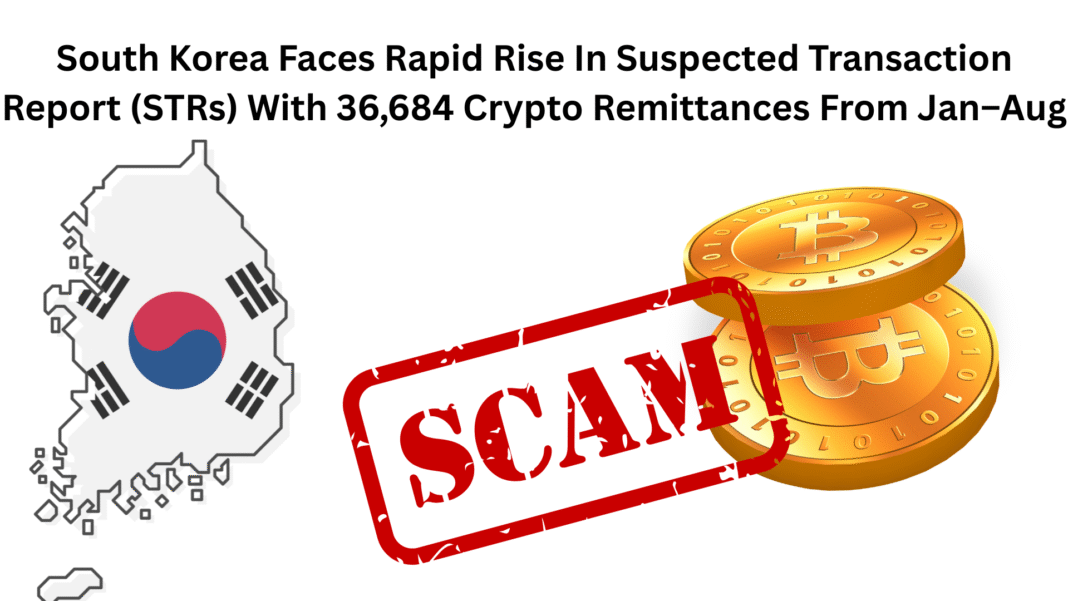Domestic virtual-asset investors and local crypto operators are at the heart of a widening probe in South Korea into suspected illegal remittances.
Officials are examining transactions believed to be money laundering and illicit foreign exchange.
The figures span January to August this year and go back to 2021. Investigators say offenders convert cash into cryptocurrency on overseas platforms, send the coins to domestic exchanges, and then cash out.
Stablecoins are often used in these moves, allowing funds to cross borders without going through banks.
Big jump in suspicious transaction reports
The number of suspicious transaction reports filed by virtual-asset firms has risen fast.
From January to August this year, operators filed 36,684 Suspected Transaction Reports (STRs). That single stretch beats the combined total of 35,734 from 2023 and 2024.
Annual filings were 199 in 2021, 17,977 in 2022, 16,076 in 2023, and 19,658 in 2024, and the rise shows a clear acceleration in cases this year.
Under the Specific Financial Information Act, domestic virtual-asset operators must tell the Financial Intelligence Unit when they see signs of money laundering.
The rule also covers so-called currency exchange schemes. In those schemes, cash is turned into crypto at foreign platforms without going through banks, then shifted to Korean platforms to be withdrawn.
Large sums sent to prosecutors
Customs records for 2021 through August 2025 show the scale of cases that reached prosecutors. The total value forwarded to the prosecution is KRW 9.5613 trillion ($6.8 billion).
Of that amount, KRW 8.6235 trillion ($6.1 billion) involves money-laundering type crimes. That equals 90.2% of the total value sent to prosecutors.
These sums point to not just many small cases but several very large ones. Officials say the money often crosses borders in ways that make it hard to trace. That complicates enforcement and raises the risk of more funds slipping through standard controls.
Stablecoins under scrutiny
Stablecoins have surfaced in several probes, and in May, customs authorities found a money changer who took roughly KRW 57.1 billion ($40 million) in cash from a Russian importer and moved that value into Tether’s USDT. That case highlights how dollar-linked stablecoins can be used to hide the origin and flow of funds.
As stablecoins gain real-world use for payments and settlement, officials worry that they can also become a quick route for disguised foreign exchange transactions. The peg to fiat and wide acceptance at overseas platforms make stablecoins attractive for those seeking to move value fast.
Lawmakers urge tougher action
Rep. Jin Seong-jun, a member of the National Assembly’s Planning and Finance Committee, shared the FIU data and called for stronger measures.
He warned that as stablecoins spread, the chance that they will be misused for foreign exchange crimes rises. He asked the Korea Customs Service and the FIU to craft systematic responses for these new methods.
Those steps, he said, should include better tracking of criminal funds and tools to block masked remittances. Lawmakers and regulators are now pushing to close gaps that let funds cross borders with little oversight.
What comes next?
Authorities face a fast-moving problem, and the growth in reports and the large sums involved means that simple rule tweaks may not be enough.
More cross-agency work is needed, including tighter monitoring of offshore platforms, quicker data sharing, and stronger checks on firms that convert cash into cryptocurrency.
The trend signals a warning to investors and businesses. Greater scrutiny is coming. Firms that fail to file proper reports risk penalties. And users who trade via unstable channels may find their transactions frozen or reversed as investigators follow the money.
Also Read: South Korea’s BDACS Debuts First Korean Won–Backed Stablecoin KRW1 On Avalanche


